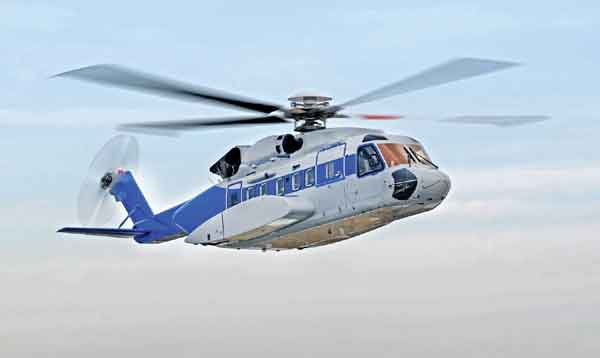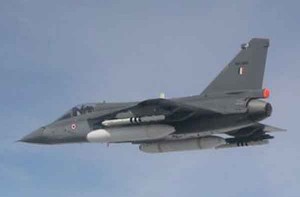Clearly the aerospace needs of India, civilian as well as defence, are growing. The public sector which has so far been tasked to meet these needs has failed to deliver. What’s more, as aerospace production becomes more complex, the public sector is likely to fall even further behind in the race. Vested interests have long fostered the myth that private sector companies are less likely to uphold the national interest than the PSUs. The private aerospace industry has been kept in a stranglehold and not allowed to realise its potential. Isn’t it strange that reputed firms like Tata, Birla and M&M have been given the cold shoulder because HAL is supposedly more trustworthy when it comes to defence matters? Yet Boeing is a reliable partner in America’s defence, Airbus in Europe’s and Embraer in Brazil’s. The government must realise that both public and private sectors are national assets; both are necessary to achieve self-reliance in the shortest possible time.
India still has to import most of the raw materials necessary for aerospace manufacturing…
Is aerospace manufacturing the next sunrise sector of the Indian economy? The signs are promising. Years of robust economic growth (notwithstanding the current slowdown) coupled with increasing demand for aviation services from the country’s teeming millions mean that a massive expansion of aerospace activities is probably imminent. Airbus Executive Vice President of Strategy and Marketing Kiran Rao says, “India has one of the world’s greatest aviation growth potentials” and is a “strategically important market.” His words are not just marketing hype. A joint report by the global consultancy KPMG and the Federation of Indian Chambers of Commerce and Industry (FICCI) published in March 2014 states, “India has the potential to become the third largest aviation market by 2020 and the largest by 2030.”
Several factors also favour the development of a vibrant domestic aerospace manufacturing sector. India has a well-educated, highly-motivated and talented workforce and rising prowess in Information Technology (IT). And it has a strong and growing low-cost manufacturing base. According to analysts, the country offers cost advantages of between 15 and 25 per cent in manufacturing.
Till now aerospace demand has been overwhelmingly met by imports but it is only a question of time before the Indian industry grabs emerging opportunities with both hands. And while businesses will naturally seek mainly civilian openings, at least to begin with, aerospace manufacturing cannot be neatly divided into military and civilian. The continuing liberalisation of defence procurement, together with huge offset requirements, makes the manufacture of military aerospace components and equipment particularly attractive. However, many hurdles remain to be crossed.
Despite the stated intention of the government to integrate private parties in aerospace, its policies actually favour the public sector…
The Sad State of Indian Aerospace
To begin with, the country’s aerospace knowledge base is still small. Hardly any universities offer degrees in aviation technology. India’s leading industrial houses such as Tata Sons, Mahindra & Mahindra, Reliance Industries and Larsen & Toubro might so easily have become Tier 1 suppliers of integrated aerospace assemblies – like Japan’s Mitsubishi Heavy Industries and Kawasaki Heavy Industries, both of which are closely associated with global aerospace giants. Yet only a handful of private businesses have ventured into aerospace manufacturing. Over the last five or six years, for instance, a few Tata companies and Mahindra & Mahindra’s aerospace division have been acquiring competence in producing parts like the aircraft fuselage and tail section, besides aeronautics design, aerospace technology and electronics. While M&M owns an Australia-based aerospace company that produces small civil aircraft, Hyderabad-based Tata Advanced Systems has a joint venture with Sikorsky Aircraft Corporation to manufacture Sikorsky S-92 helicopter cabins and other airframe components in India.
However, such items are the easiest part of the aerospace production chain; other components such as engines and flight avionics are far more complex. Despite the stated intention of the government to integrate private parties in aerospace, its policies actually favour the public sector. The private sector on the whole is a peripheral player, restricted to low-tech items and components.
India still has to import most of the raw materials necessary for aerospace manufacturing and lacks adequate capability in new material technologies. Partnerships with leading international aerospace entities can help Indian companies acquire competence in cutting-edge technologies like the production of composites. However, the short-sighted government policy on Foreign Direct Investment (FDI) limits overseas Original Equipment Manufacturers (OEMs) to just 26 per cent stake in domestic aerospace manufacturing. Even critical sectors such as telecom and banking have much higher limits. This naturally makes the OEMs unwilling to partner Indian companies in advanced aerospace manufacturing. The OEMs are content to order some low-tech items and services merely to meet their offset obligations.
HAL thrives primarily due to its monopoly and government patronage, rather than any inherent excellence…
Defending the Indefensible
India’s aerospace manufacturing sector is highly fragmented. Various public and private sector organisations are blissfully unaware of what the others are doing. For instance, the activities of the Defence Research & Development Organisation (DRDO) and Hindustan Aeronautics Limited (HAL) are confined to the defence sector while National Aerospace Laboratories (NAL) and a few civilian companies are mainly limited to the civil sector and are probably ignorant of the progress being made in defence aerospace. This results in wasteful duplication of effort. On the other hand, the world’s largest aerospace entities such as Airbus, Boeing and Embraer are active in civilian as well as military aerospace, sharing the capabilities and knowledge of their various divisions and synergising their efforts thus yielding benefits to all.
In 2001, the Ministry of Defence (MoD) realised that defence production could not meet the country’s needs so long as all its eggs were in the public sector’s basket. Defence production was deregulated and ostensibly thrown open to private companies. But on the ground little has changed regarding many critical defence items and practically nothing when it comes to aerospace. Besides being cold-shouldered for most aerospace deals, the private sector faces a disadvantageous taxation regime that lowers its competitiveness vis-à-vis public sector and foreign companies. For instance, an overseas company executing a defence supply contract enjoys various tax concessions. But an Indian private manufacturer producing the same item may end up paying more than 30 per cent extra tax.
The much-hyped self-reliance in defence aerospace remains a distant dream. One reason is that licensed production or assembly is often passed off as indigenisation. Another is that equipment purchased from Indian suppliers used to be reckoned as indigenous, even if it contained 80 to 90 per cent foreign components. The indigenous content of the Tejas Light Combat Aircraft (LCA), for instance, is just about 60 per cent. However, with the Defence Procurement Procedure (DPP) 2013 now in force, import content in the products supplied by sub-vendors does not reckon towards indigenous production. This is an important step to make organisations like HAL more accountable and committed to genuine indigenisation.
Finally, infrastructure and government support – both essential ingredients of success – are sorely lacking. Neither is there clear government backing for private aerospace manufacturing nor policy direction. Recipients of most transfer of technology deals are invariably Defence Public Sector Undertakings (DPSU), even though a private concern may be more competent to absorb and employ the technology. All major deals are signed directly with foreign producers and the public sector continues to get bulk orders, ostensibly under Transfer of Technology terms. There appears to be lack of commitment to authentic indigenisation involving the private sector.
The much-hyped self-reliance in defence aerospace remains a distant dream…
Due to these shortcomings, and despite the best of intentions, defence aerospace manufacturing has not really taken off. Overall defence imports are inching upwards towards 75 per cent, instead of falling towards the desired 30 per cent and most critical aerospace items have to be imported. Many believe that HAL is at least partly responsible for this state of affairs.
HAL’s Mixed Report Card
Since Independence, state-owned behemoth HAL has been practically synonymous with Indian aerospace. It has 19 Production Units and ten Research & Design Centres at eight locations across the country. It has an impressive product track record – 15 types of aircraft manufactured with inhouse R&D and 14 types produced under licence mainly for the Indian Air Force (IAF), its largest customer. It has built up comprehensive skills in design, manufacture and overhaul of fighters, trainers, helicopters, transport aircraft, engines, avionics and system equipment. It also delivers life-cycle and product support services.
However, to say that HAL is unable to meet the needs of the IAF is an understatement. Practically every IAF project it undertakes is subject to massive cost and time overruns and unmet operational requirements. Moreover, since it is under the rigid control of generalist bureaucrats, who are more interested in meeting short-term targets than in fostering design competence and technological growth, it has not succeeded in providing leadership and momentum to Indian aerospace. The exclusion of commercial expertise keeps it perpetually behind the times. This partly explains why India, despite its impressive advances in space exploration, telecom, and IT and software services, has made very little progress in aerospace manufacturing.






